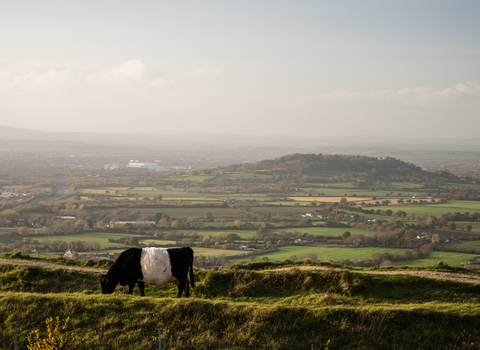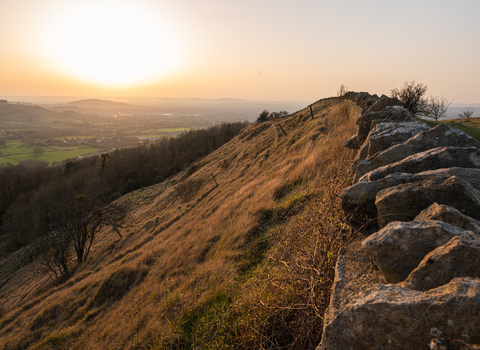Crickley Hill, which is jointly managed by Gloucestershire Wildlife Trust and the National Trust, is rich in wildlife and archaeology. Perched high above the city of Gloucester and the Severn Plain, the views are tremendous.
Discover more about the wildlife and history of Crickley Hill below, as well as more information about the A417 road improvement scheme.
Please be sure to buy a parking ticket to cover the full length of your stay. You can find more about parking at the bottom of the nature reserve page.
More than 1,300 species have been recorded here, from rare birds, butterflies and reptiles to wildflowers and toadstools. Crickley Hill is recognised as a Site of Special Scientific Interest (SSSI) for its splendid diversity of wildflowers and geology.
More than half the UK’s butterfly species have been recorded here, while birds like long-tailed tits and chiffchaffs can be seen in the woodlands and scrub areas.
The grassland is maintained with the help of belted Galloway cattle, managed by the National Trust. This eye-catching breed, with its black and white bands, originates from the harsh upland climate of the Galloway hills in south-west Scotland. Renowned for being hardy, they are able to cope with slopes and thrive on grasses that are lower in nutrients.
As well as being nationally important for wildlife, Crickley Hill has played a notable role in the history of Gloucestershire and beyond, with several violent events taking place here in ancient times.
There is evidence of settlements including an enclosure with a causeway that was rebuilt several times after aggressive attacks. This was later replaced by an Iron Age hill fort, still visible today, which would have been a triangular patch on top of the hill covering more than three hectares. A rubble-cored, timber-laced rampart surrounded the settlement, which was home to around 100 people, with a rock-cut, flat bottomed ditch running parallel to the rampart.
The hill fort was burned and abandoned during the sixth century BCE, with more than 400 arrowheads discovered at its entrance, indicating that a battle took place. Today this hill fort is considered to be of international importance and there’s also evidence that it was used for worship, particularly in the area known as the ‘Long Mound’, which had a shrine, stone circle and processional way used for rituals and religious purposes from 3700 BCE to 500 CE.
Excavations on Crickley Hill were one of the largest and longest running of their kind in the UK, taking place from 1969 to 1993, with large areas of the thin soil being examined every summer. The Crickley Hill Country Park was established in 1979 with assistance from the Countryside Commission. Since then, visitors have enjoyed easy access to its limestone grassland, beech woodlands, archaeological remains and panoramic views.
Today, GWT and the National Trust share joint ownership of the land and work together as custodians of this delicate, much-loved, and well-used wild place, protecting and enhancing its special wildlife and archaeology for the enjoyment and benefit of current and future generations.




